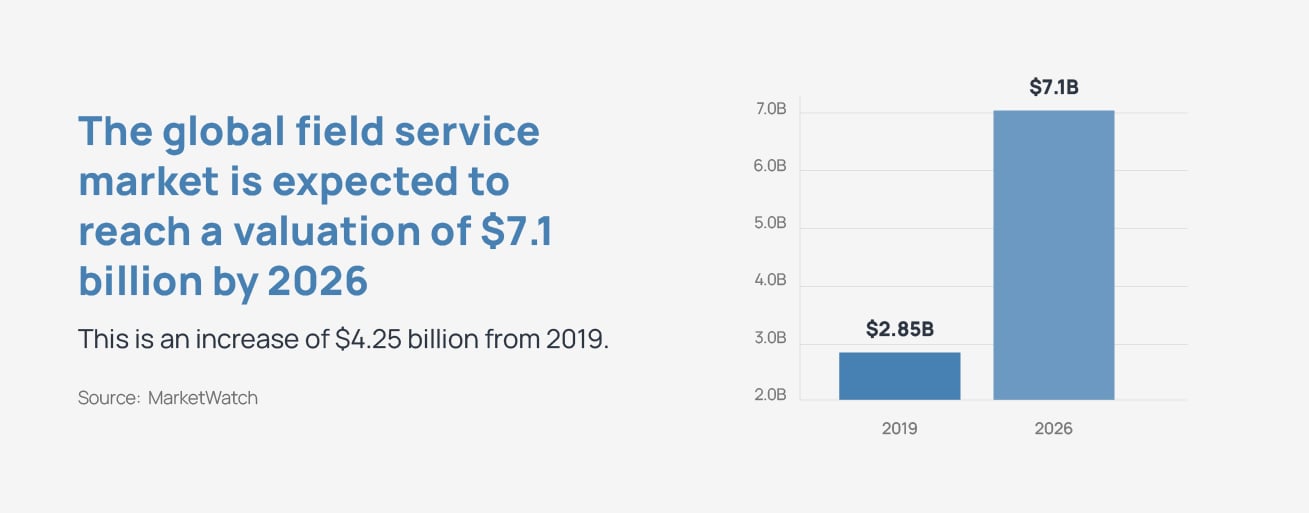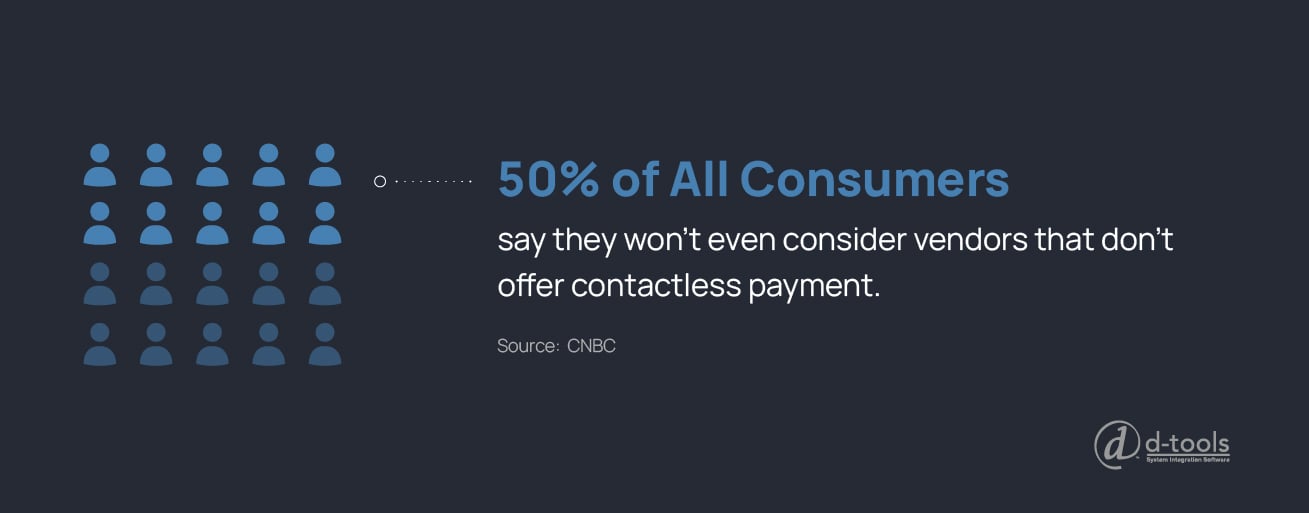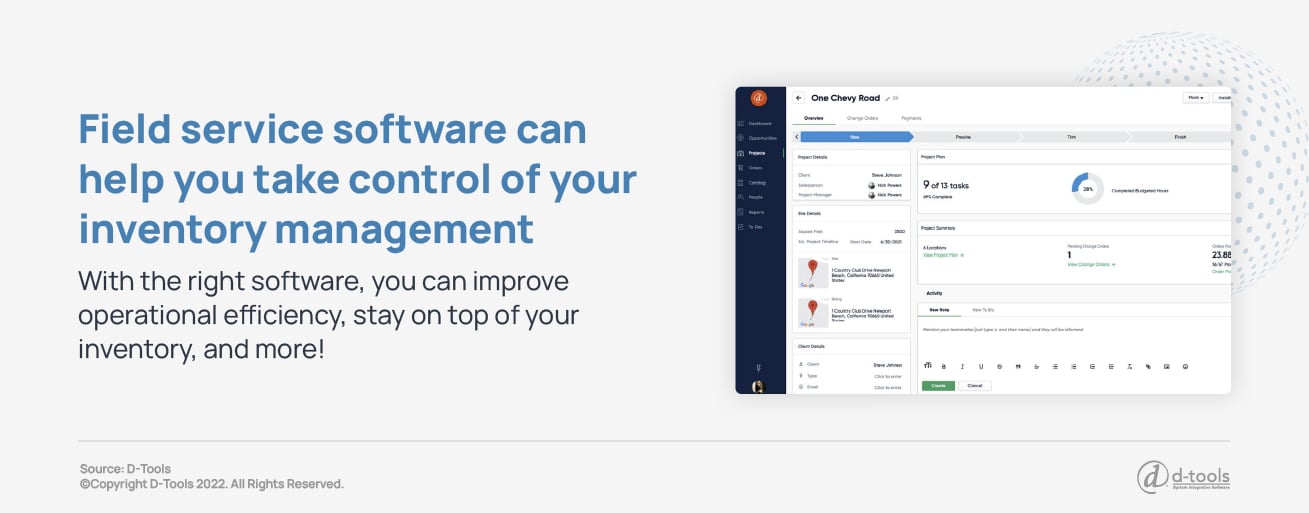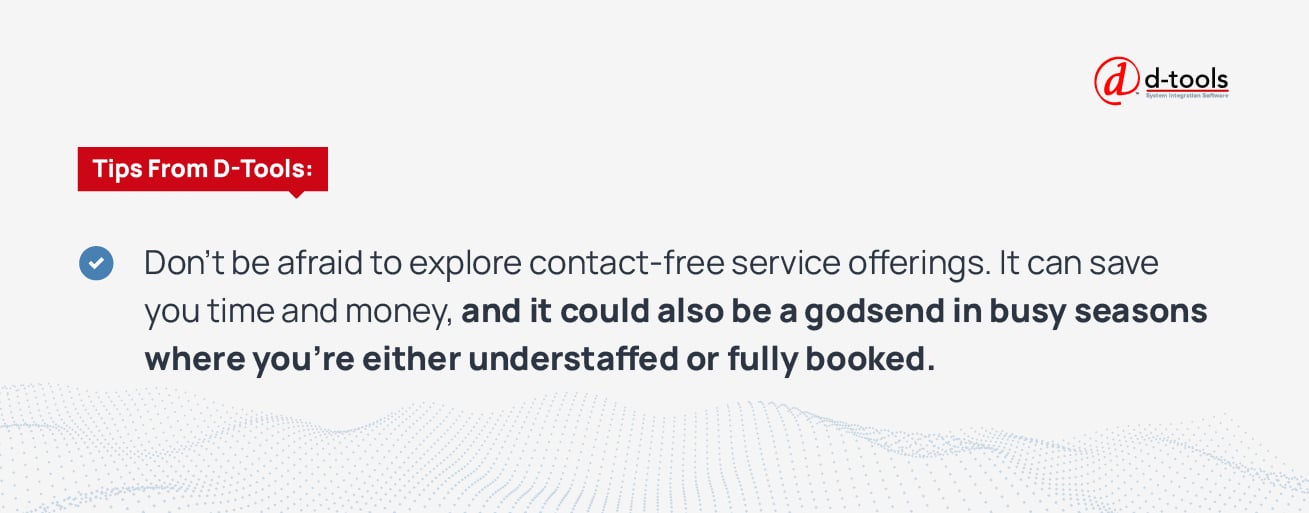The field service market did more than simply survive the pandemic.
It thrived within it, soundly beating all expectations and laying the groundwork for an increasingly vibrant future.

In 2019, the global field service market was valued at $2.85 billion. It has since grown at a compound annual growth rate (CAGR) of over 15% and is expected to reach a valuation of $7.1 billion by 2026.
These astounding statistics affirm two key truths: first, that in-person service will likely never lose demand, even in the midst of public health crises. Second, advancements in automation, cloud technologies, and interconnectivity have enabled field service management to adapt to the 21st century and truly help define it.
As we finish the first quarter of 2022 and head into the spring, here are five considerations to help refine your field service management strategy.
1. The Demand for Broader Payment Infrastructure
It’s no secret that we’re living in an increasingly cashless society.
Though there is plenty out there on the subject, it’s most simply explained as the product of an already digitized economy accelerated by a global pandemic.
The exchange of physical currency has become a relic of the past. Even credit card giants like Mastercard have plans to phase out the physical swiping of cards by 2023.
Recent statistics further underpin this development. By 2025, non-cash transactions — i.e., payments made with digital wallets, QR codes, and even cryptocurrencies — are expected to exceed one and a half trillion (growing at a CAGR of 18% over the next few years).
The point is this: the payments landscape is rapidly evolving. As a business professional, these trends are worth your attention.
People are getting picky about how they pay.

In fact, 50% of all consumers say they won’t even consider vendors that don’t offer contactless payment. While that may sound vaguely threatening, it’s ultimately an opportunity for you and your business.
That’s why 63% of companies claim that offering more payment methods is ultimately a "competitive advantage."
As you look ahead to the second half of 2022 and beyond, consider ways to expand your cache of available payment methods.
>> Related Read: 5 Ways to Generate Recurring Business Income
2. The Relevance of Inventory Management
Cashless payments are a prominent part of the pandemic’s enduring legacy.
Unfortunately, not all of COVID’s cultural progeny are so inventive. Supply chain issues remain an existential threat to the industrial world. Shelves are understocked, and prices remain high across the board for many U.S. firms.
While it’s easy to take to Twitter and voice discontent, effective field service businesses focus on the things that can be controlled.
One such realm — and perhaps the most essential — is inventory management. While you can’t dictate the price and availability of goods, you can be the master of your own domain. To that end, you have the power to manage your clients’ expectations when products are either in or out of stock.
To combat these uncertain times, invest in field service software that streamlines communication and integrates with an inventory management tool like TRXio.

There are too many variables at play to adhere to manual processes. With the right tech stack in place, you can improve operational efficiency, stay on top of your inventory, protect your business, and manage your client’s expectations with just a few mouse clicks.
By leveraging field service software with an integrated inventory management solution, you’ll gain:
- Ready access to product status (i.e., requested, purchased, received, staged, delivered) throughout the project workflow
- Precise inventory tracking that leads to time and cost savings
- Improve communications between the office/warehouse and the field
- Increased field efficiency
- Reduced inventory for better cash flow management
While the most destructive aspects of the pandemic may be easing, the supply chain remains more fragile than ever. According to the U.S. Department of Commerce, shortages and issues will likely persist throughout 2022.
Protect your team by incorporating the right tech stack into your business.
3. The Need to Continue Training Your Workforce
When it comes to field service management best practices, training is everything.
Modern technicians are often faced with tremendous pressure. Each time they go on-site, they’re expected to have answers and solutions to practically every problem that arises.
Plus, on top of needing to have detailed knowledge of the devices they’re installing or fixing, they must also have the confidence to work in a range of environments and build rapport with all kinds of personalities. In other words, they must not only have a high level of technical proficiency, but the soft skills needed to deliver top-tier customer service.
Businesses must provide the necessary training to develop and enhance these traits within their workforce. After all, a company is only as strong as its employees — especially in the world of field service management.
Remember: every time you send a technician into the field, they’re putting your company’s reputation on the line.
>> Related Read: 5 Ways to Improve Field Service Technician Utilization
Fortunately, you don’t need to become a full-time teacher to train your clients. Digital technology and online portals can provide access to training materials around the clock, so your team can study, grow, and practice at their own pace.
Recent advancements in the mixed reality space mean your team can consider using state-of-the-art technologies to train in a hands-on and safe environment.
While technicians can often feel isolated in the field, augmented reality (AR) and virtual reality (VR) tools can provide digital mentorship where people aren’t available.
Note: Don’t hesitate to leverage your veteran technicians’ expertise in teaching your newer team members. Their perspective is invaluable. And even if you’re required to increase your budget, know that every dollar you invest in training will yield a rewarding ROI down the line.
4. The Value in Providing Remote Service Offerings
There’s no doubt about it: most field service management scenarios require in-person service. You need boots on the ground to meet customers, diagnose issues, and install devices. As we discussed above, the demand for such service isn’t going anywhere.
Still, remote project management has increasing viability — especially in the wake of a global pandemic. Prior to 2020, companies with remote tools were looked at with skepticism. Today, those early adopters are widely heralded as geniuses.

Don’t be afraid to explore contact-free service offerings. For one thing, any problem you can solve remotely and without dispatching your personnel saves time and money. Plus, offering remote services could be a godsend in busy seasons where you’re either understaffed or fully booked.
Finally, and without sounding alarmist, it’s important to note that many scientists and world leaders are already talking about the next pandemic as if it’s an inevitability. While we can only hope that such expectations are wrong, it’s certainly advisable to plan for all contingencies and stand ready for any potential outcomes.
Again, we’re not suggesting you invest in remote and contact-free service out of fear. Instead, we’re suggesting that doing so could enhance your business offerings, promote efficiency, and deliver field service solutions with safety — no matter what’s happening in the world.
>> Related Read: 8 Field Service Challenges and How to Overcome Them
5. The Need for Collaboration Tools
As technology has become more democratic, consumers have grown more confident. Businesses should capitalize on this trend by providing self-service customer portals.
On one level, portals help streamline communication between the company and the consumer. Indeed, these tools are often the first point of contact between a business and its client.
More importantly, portals empower the client to take action, dictate their needs, and ultimately shape their own customer experience. With such collaboration tools, customers can use their desktop computer, tablet, or smartphone to report problems, ask questions, request a service, or simply track the status of a project.
Customer portals ultimately ease the burden on technicians, as they become liberated from the need to answer questions and can instead focus on their assignments without distraction.
With the D-Tools Customer Portal, you can effortlessly streamline client communication throughout the project lifecycle. Users can publish proposals, contracts, change orders, and other essential client-facing documentation necessary to enhance client engagement.
More importantly, clients can log in to a secure web portal and review that documentation, make comments, create e-signatures for proposals, and much more.
D-Tools offers two software solutions for field service management, and both include the Customer Portal functionality: System Integrator (SI) and D-Tools Cloud.
>> Click Here to Find Out Which D-Tools Product Is Best for You





